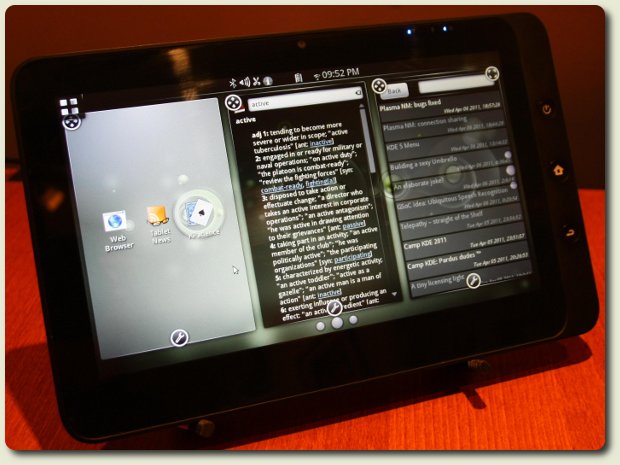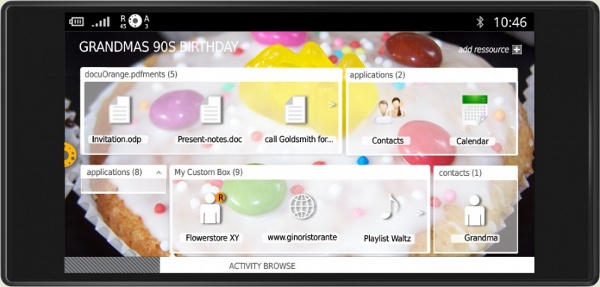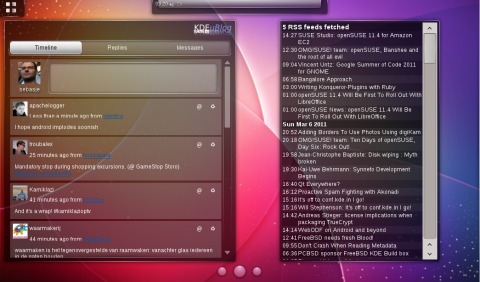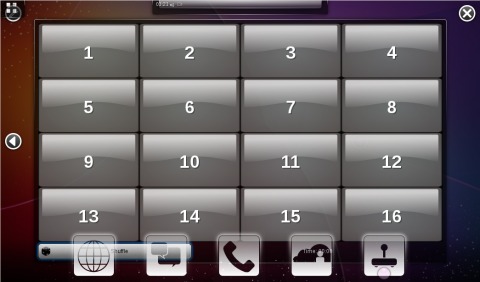Plasma Active for portable devices
As part of the Plasma Active project, an initial prototype of a new user interface organization concept has been prepared for a wide range of embedded devices that go beyond conventional laptops and PCs, for example, for Internet tablets, media centers and smartphones. A key area of new shell development is the development of tools to provide an interactive, rich and convenient user interface.

Under the cut image of the interface, as well as video
Plasma Active runs on top of the standard Linux desktop stack, which includes the Linux kernel, Qt, and the KDE Plasma Framework. Existing desktop technologies involved in Plasma Active are optimized for building a specific interface for various types of devices. The first release of Plasma Active focuses on the support of touch screens and tablet computers, the interface for which is built with an eye to the heavy use of social networks, navigation on the Web and work with multimedia content. Among the features are also noted tools for organizing collaboration and data exchange between users, using a P2P distribution system instead of a centralized application catalog building model. The first release of Plasma Active, designed to work on tablets, is scheduled to be released in September.

An important part of Plasma Active is the Contour project, which is working to create a new desktop paradigm. The main idea of Contour is to transition to a content-oriented interface that adapts to the current context, areas of activity, and user behavior patterns. In other words, the interface becomes oriented not to applications, but to data, intelligently combining data using a context-sensitive recommendation manager.

Among the devices currently supported are the ViewSonic Viewpad 10 and WeTab tablets, as well as the Lenovo Ideapad 10 netbook. For testing Plasma Active, a bootable Live image (1.2 GB) based on openSUSE 11.4 has been prepared . Plasma Active sources can be downloaded from a special repositoryReady-made binary packages are currently available only for openSUSE and MeeGo. To visually assess the capabilities of Plasma Active, a small demo video was created.
The interface in Plasma Active is built on the basis of the Plasma shell version, which is switched to using the Qt Quick declarative interface description technology, which allows you to easily dynamically create a user interface whose structure and parameters are set by CSS-like blocks, and the logic is determined using a JavaScript-like QML language . The QML-based interface allows you to achieve great flexibility in changing the appearance (the interface is completely separate from the code and easily adapts to a specific mobile device, taking into account resolution, DPI, screen orientation and interface features). In addition to widgets built on the basis of Qt Quick in Plasma Active, classic widgets are also allowed.

According to the idea of the developers, applications written for Plasma Active will be able to run on various classes of devices, from tablets and set-top boxes, to handheld computers and smartphones, regardless of screen size and type of data input system. The application interface can easily be redesigned using a CSS-like style system. Currently, two subprojects are being developed: plasma-mobile and plasma-tablet, which differ in the organization of the desktop space. The desktop itself is identical in both systems, but different shells are launched on top of it, optimized for different screen resolutions.

Among the functions planned for the future, we can note: support for multi-touch navigation, gesture control (for example, pinch zoom), support for locally installed web services, creation of web-based widgets (for example, for viewing news and tracking RSS), integration of Facebook support . Among the basic applications that are planned to be developed, mobile versions of the Calligra office suite and Kontact personal information manager are named.

A source

Under the cut image of the interface, as well as video
Plasma Active runs on top of the standard Linux desktop stack, which includes the Linux kernel, Qt, and the KDE Plasma Framework. Existing desktop technologies involved in Plasma Active are optimized for building a specific interface for various types of devices. The first release of Plasma Active focuses on the support of touch screens and tablet computers, the interface for which is built with an eye to the heavy use of social networks, navigation on the Web and work with multimedia content. Among the features are also noted tools for organizing collaboration and data exchange between users, using a P2P distribution system instead of a centralized application catalog building model. The first release of Plasma Active, designed to work on tablets, is scheduled to be released in September.

An important part of Plasma Active is the Contour project, which is working to create a new desktop paradigm. The main idea of Contour is to transition to a content-oriented interface that adapts to the current context, areas of activity, and user behavior patterns. In other words, the interface becomes oriented not to applications, but to data, intelligently combining data using a context-sensitive recommendation manager.

Among the devices currently supported are the ViewSonic Viewpad 10 and WeTab tablets, as well as the Lenovo Ideapad 10 netbook. For testing Plasma Active, a bootable Live image (1.2 GB) based on openSUSE 11.4 has been prepared . Plasma Active sources can be downloaded from a special repositoryReady-made binary packages are currently available only for openSUSE and MeeGo. To visually assess the capabilities of Plasma Active, a small demo video was created.
The interface in Plasma Active is built on the basis of the Plasma shell version, which is switched to using the Qt Quick declarative interface description technology, which allows you to easily dynamically create a user interface whose structure and parameters are set by CSS-like blocks, and the logic is determined using a JavaScript-like QML language . The QML-based interface allows you to achieve great flexibility in changing the appearance (the interface is completely separate from the code and easily adapts to a specific mobile device, taking into account resolution, DPI, screen orientation and interface features). In addition to widgets built on the basis of Qt Quick in Plasma Active, classic widgets are also allowed.

According to the idea of the developers, applications written for Plasma Active will be able to run on various classes of devices, from tablets and set-top boxes, to handheld computers and smartphones, regardless of screen size and type of data input system. The application interface can easily be redesigned using a CSS-like style system. Currently, two subprojects are being developed: plasma-mobile and plasma-tablet, which differ in the organization of the desktop space. The desktop itself is identical in both systems, but different shells are launched on top of it, optimized for different screen resolutions.

Among the functions planned for the future, we can note: support for multi-touch navigation, gesture control (for example, pinch zoom), support for locally installed web services, creation of web-based widgets (for example, for viewing news and tracking RSS), integration of Facebook support . Among the basic applications that are planned to be developed, mobile versions of the Calligra office suite and Kontact personal information manager are named.

A source
